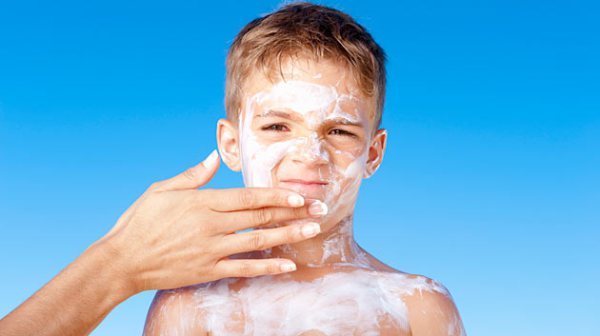- PocketDerm is now Curology! Read the blog post from our CEO to learn more.

It’s summertime and while the living is easy, being protected against the sun isn’t always, especially if you’re dealing with acne at the same time! There are so many choices out there that finding a sunscreen that won’t worsen your breakout can seem impossible. Here are the most important things to know about sunscreen so that you feel confident about your skin safety while you’re rocking those skin-baring swimsuits!
UVA VS. UVB

Sunscreens that protect against UVA and UVB are often described as being “broad-spectrum.” But what exactly are UVA and UVB? The sun’s UV (ultraviolet) light rays are classified into UVA, which are a longer wavelength, and UVB, which are shorter.
UVA
- Main cause of aging and wrinkling – photoaging
- Contributes to the development of skin cancer
- Penetrates through clouds and glass – think of the sun exposure in your car!
- Penetrates deeper into the skin compared to UVB
- Major contributor to tanning (skin darkening is a response to sun damage and injury to the skin’s DNA—there is no such thing as a healthy tan!)
UVB
- Main cause of redness and sunburn
- Contributes to the development of skin cancer
- Penetrates through glass, but less than UVA
SPF VS. PPD
SPF (Sun Protection Factor) is a measure of a sunscreen's ability to prevent UVB and some UVA rays from damaging the skin. It is based on how quickly redness forms on sunscreen-protected skin compared to unprotected skin. This is measured as MED (minimal erythema dose, or ‘‘the smallest UV dose that produces perceptible redness of the skin with clearly defined borders at 16 to 24 hours after UV exposure").
Sunscreens with an SPF of 15 or higher protect well against UVB. For extended outdoor activity, you will want to use a water-resistant, broad-spectrum (UVA/UVB) sunscreen with an SPF of 30 or higher.
No need to get too wild with higher SPFs: SPF was more important 20 years ago, when SPFs were low and most sunscreens were narrow spectrum. Sunscreens these days protect very well against UVB, so SPF is not as important as finding a sunscreen that you like and and that is affordable!
PPD (persistent pigment darkening) is often used to describe the UVA protection factor of Asian sunscreens. It measures the minimal UVA radiation dose required to induce the first perceptible pigmentation changes (i.e., minimal pigmenting dose) in sunscreen-protected skin compared to unprotected skin. Sunscreen products are then rated as PA1, PA11, PA111, or PA1111 (where higher numbers indicate increasing UVA protection).
PHYSICAL VS. CHEMICAL
Sunscreens can be classified as physical, chemical, or both, depending on their ingredients.
Physical sunscreens
- Contain titanium dioxide and/or zinc oxide
- Physically reflect or “bounce” sunlight away from the skin
- Can leave a white cast on the skin unless rubbed in well, micronized, or tinted
- Start protecting immediately upon application
Chemical sunscreens
- Contain ingredients such as avobenzone and oxybenzone
- Absorb UV light so that the light is prevented from penetrating the skin
- May occasionally be irritating or cause allergic reactions
- Require 20 minutes after application for full effect
APPLICATION

Most of us do not apply enough sunscreen! For the face and neck, up to a half teaspoon may be needed, especially if you use your whole hands to rub in the sunscreen. For the body, 1 ounce or 2 tablespoons is enough for one application. Studies show that most people apply only half to a quarter of that amount, which means that the actual SPF they have on their body is lower than advertised. During a long day at the beach, one person should use around one quarter to one half of an 8 oz bottle!
If using a chemical sunscreen, remember to apply half an hour before going outside.
No sunscreen, regardless of strength, should be expected to stay effective longer than two hours without reapplication. That being said, the reapplication of sunscreen depends on what your activities are for the day. If you are inside working all day, I would not worry about reapplying at all. If you're in and out, I'd reapply at least midday. If you are going to be out for extended periods during the day, then your goal is to re-apply every 2 hours or so, especially if you are going in and out of water or if you are sweating or wiping your face.
ALTERNATIVE METHODS OF PROTECTION
Of course, sunscreen is just one weapon in your arsenal against sun damage. Don’t forget about hats, (UV protective) sunglasses, clothing, and seeking the shade!
Those who plan on spending a lot of time in the sun may want to consider a dietary supplement called Heliocare. Heliocare capsules contain Polypodium leucotomos, an extract of a fern found in Central and South America that has been used for centuries to treat skin disorders. These powerful antioxidants help to combat the free radicals produced during sun exposure, decreasing sunburn response and possibly helping to combat long-term sun damage.
If you’re looking for that summer glow without the risk of sunburn or skin cancer, check out our blog post on sunless tanners. However, remember that these offer little to no sun protection, so they are not a replacement for sunscreen!
RECOMMENDATIONS
Here are some sunscreens that shouldn’t promote acne, categorized by skin type:
For normal-to-oily skin
- Cetaphil Dermacontrol Moisturizer SPF 30 (no white tint)
- Murad Oil-Control Mattifier SPF 15 (good for everyday use, but the SPF may be too low for outdoor activities)
- Neutrogena Oil Free Moisture SPF 35
- Neutrogena Pure and Free Liquid, SPF 50 (almost no white cast)
- Neutrogena Healthy Defense Daily Moisturizer with Helioplex, SPF 50 (lightweight and non-greasy)
For combination or in-between skin
- EltaMD UV Clear SPF 46 (my all-around favorite!)
For dry/sensitive skin
- Vanicream Sunscreen SPF 30
- Tizo Solar Protection Formula, Facial Mineral Fusion SPF 40 (great physical sunscreen with a light tint)
For dark skin
- La Roche Posay Anthelios SPF 60 (no cast)
For sports, swimming, sweaty activities
- Solbar Zinc SPF 38 (has an oil free base that lasts for up to 80 minutes in the water, is more rub resistant than most, and is gentle on the eyes)
TIPS
- Applying moisturiser beforehand facilitates smooth application without annoying pilling (like when little white bits come off—ugh).
- Allow time for sunscreen to dry before putting on makeup.
- Remember, no sunscreen is a complete block—no matter what the SPF is!
- You won’t use it unless you like it, so the biggest key is finding a sunscreen you like!
Jasmin Chang, RN, AGNP-C
Jasmin Chang is a board-certified nurse practitioner at PocketDerm, where patients can see a health care professional online for comprehensive acne and anti-aging treatment. Jasmin completed her undergraduate studies at UC San Diego, graduated with her Master of Science in Nursing at UC San Francisco, and is currently based in San Diego, CA.
Interested in trying PocketDerm? Click here for a free trial.
Just-for-you skincare formulated by board-certified dermatologists and delivered to your door.


